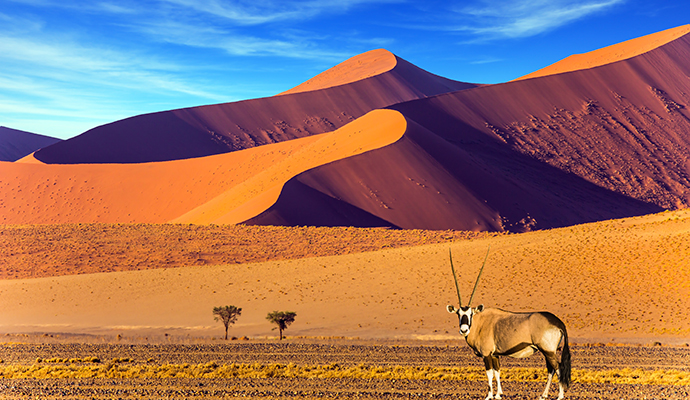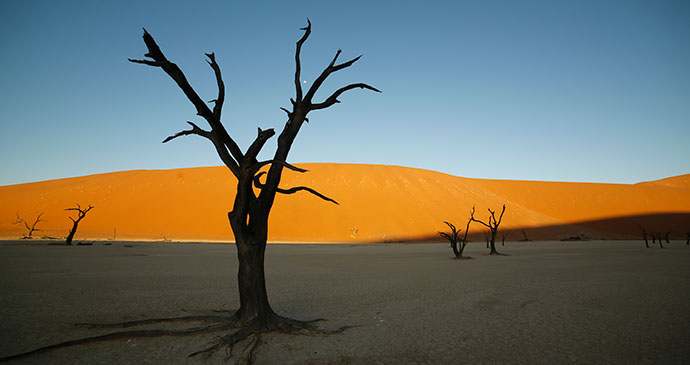Where to find life
The Namib Desert receives its stingy allotment of water in two ways. Its eastern edges, near the escarpment, get rare showers of rain. There you will find inselbergs, which can store the water for a time and support permanent communities of perennial plants and resident animals. At the coast, the desert’s western edge, the annual rainfall is even lower (less than 5mm at Walvis Bay), and there most organisms rely on the fogs which regularly roll in from the sea. However, in the middle of the desert where neither the rain nor fog reach, there is very little life indeed.
Surviving in the Namib: by escaping
Many of the Namib’s species can only survive at all if they either escape or retreat from the extremes. An ‘escape’ is an extended period of absence from the desert community, such as a suspension of the life cycle, aestivation (the desert equivalent of hibernation) or by actually migrating out of the desert. Many of the Namib’s plants stop their life cycle for particularly harsh periods, leaving behind dormant seeds able to withstand temperatures of up to 100°C and remain viable for years.
Growth is eventually triggered by a threshold amount of rainfall, leading to the phenomenon of the ‘desert bloom’, where a carpet of flowers covers the ground. These plants, called ephemerals, must then complete their life cycles in a matter of days before the water disappears. A blooming desert obviously requires its pollinators, so various insect species also conduct ephemeral life cycles, switching them on and off as rainfall dictates.
On the great plains of the Namib, a different community waits for rain in any slight depression. When it arrives, and the depression fills, an explosion of activity occurs and pond life comes to the desert. Algae, shrimps and tadpoles fill the ponds for their short lives, employing rapid development techniques to mature swiftly to adulthood.

Large-scale migrations are not common in the Namib, but springbok do trek between arid regions, following any rain, and the Namib’s largest mammal, the oryx, also moves in a predictable pattern. After rainfall, they move into the Namib’s dune sea, looking for the ephemeral grasses. When these vanish, they travel to the dry Kuiseb riverbed to compete with the resident baboons for acacia pods and water. Here they excavate waterholes, which they maintain from year to year.
Surviving in the Namib: by retreating
A ‘retreat’ is a short term escape, typically a matter of hours. This has a serious disadvantage: it results in what ecologists call a ‘time crunch’, where time for foraging and social activity is greatly reduced. It follows that retreating animals must be very efficient at foraging. Most species retreat to some extent. The Namib’s beetles, reptiles, birds and mammals disappear into burrows and nests during the hottest periods of the day.
One of the most visible is the social weaver bird, which builds enormous communal nests that insulate the birds during cold nights, and provide a handy retreat during the heat of the day. In order to extend the time spent on the surface, and minimise this time crunch, one Namib resident, the sand-diving lizard, has developed the remarkable behaviour of ‘dancing’ on the surface. By lifting its legs at intervals (never all at once!), it manages to reduce its body temperature and stay out for a few extra minutes of activity.
Specialised plants
Although some form of escape or retreat is practical for most animal species, plants do not have the same luxury. They cannot move quickly and therefore have to become tolerant. Most of the Namib’s plants have very deep root systems, to acquire what little ground water is available, and adaptations to reduce water loss. Their leaves are usually small and often covered in hairs or a waxy coating. These designs all reduce water loss by evaporation. Smaller leaves mean less surface area, hairs trap still air adjacent to the leaf and waxy coatings don’t allow moisture to pass through.

The swollen, waxy leaves of succulents are filled with water, and hence must be protected from thirsty grazers. They usually employ toxins, or spines, but in the Namib there are also the extraordinary geophytes, plants – such as lithops – which camouflage themselves as stones. Added to the problem of desiccation is that of overheating. Most desert plants are orientated to minimise heating, by having their narrowest edge facing the sun. Some geophytes go one better by growing almost entirely underground.
Animal adaptations
Water, the ultimate limitation of the desert, is of key importance to the Namib’s animals. Without exception, all of the animal species here tolerate extreme levels of desiccation, and some employ interesting techniques. The male namaqua sandgrouse travels miles to find water each day. When successful, he paddles in it, allowing his breast feathers to absorb water like a sponge. Laden with this cargo he travels back to the nest to feed the thirsty young and his partner.
Springbok and oryx have kidneys that are so efficient at absorbing water that a pellet form of urine is produced. The African ground squirrel faces away from the sun at all times, and uses its tail as a parasol while it forages. Perhaps most peculiar to the Namib are the dune beetles, which inhabit the crests of the desert’s taller sand dunes. They are early risers when there is fog about, and sit motionless for hours in order to allow it to condense on their bodies. Periodically they perform a spectacular dance to move the precious water along their bodies and into their mouths.
Find out more about this fascinating country with 10% off our guidebook to Namibia:
